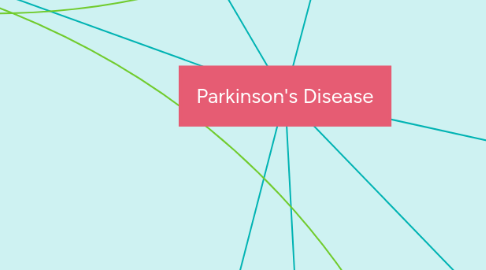
1. Treatments
1.1. Medications
1.1.1. Carbidopa-levodopa: Most effective natural chemical that is converted into dopamine in the brain.
1.1.2. Duopa (Carbidopa-levodopa infusion): This is administered through a feeding tube and is usually for patients with advanced Parkinson's.
1.1.3. Dopamine agonists: Mimics dopamine effects on one's brain and is usually less effective.
1.1.4. MAO-B inhibitors: These help prevent the breakdown of dopamine in the brain
1.1.5. COMT inhibitors: prolongs the effect of levodopa
1.1.6. Anticholinergics: help control the tremor in Parkinson's
1.1.7. Amantadine: used for early stage Parkinson's
1.2. Surgical procedures
1.2.1. Deep brain stimulation: Mostly offered to patients with advanced Parkinson's Disease.
1.3. Lifestyle Changes
1.3.1. Healthy eating
1.3.2. Exercise
1.3.3. Avoiding falls
1.3.4. Performing ADLs
2. Diagnostics
2.1. No specific test exists to diagnose Parkinson's Disease. However, some tests can be done to rule out other conditions that may cause your symptoms.
2.1.1. Blood tests
2.1.2. Imaging Tests
2.2. Patient will go to a neurologist to be diagnosed. A neurologist will review your medical history, symptoms, and perform a physical and neurological exam and then determine the diagnosis.
2.2.1. Doctor may prescribe a dose of carbidopa-levodopa (Parkinson's medication) and if improvements are seen this will confirm the diagnosis of the disease.
3. Risk Factors
3.1. Age: It is most likely seen in people that are 60 years or older.
3.2. Heredity: One who has a relative with Parkinson's will have an increased chance in developing the disease.
3.3. Sex: Males are more likely to develop Parkinson's than females.
3.4. Toxin Exposure: Exposure to pesticides and herbicides can increase one's risk of developing the disease.
4. Resources
4.1. Mayo Clinic. (2015, July 07). Parkinson's Disease. Retrieved November 18, 2017, from https://www.mayoclinic.org/diseases-conditions/parkinsons-disease/
4.2. Parkinson's Foundation. (2017, November 17). Retrieved November 19, 2017, from http://www.parkinson.org/
5. Pathogenesis
5.1. Largely considered idiopathic, only a small percentage are genetically linked
5.2. The symptoms are a result of the loss of a number of neurotransmitters, mostly dopamine.
5.2.1. Symptoms worsen overtime as more and more cells are lost due to the disease
5.2.2. Course of the disease is variable, some patients exhibit few symptoms while aging while others progress rapidly.
5.3. Stages of Parkinson's
5.3.1. Stage 1: mild symptoms that do not affect ADLs, tremor occur on only one side of body, changes in posture, facial expressions, and wallking
5.3.2. Stage 2: tremors, rigidity, and other body movements, affect both sides of body, ADLs are difficult, person can live alone
5.3.3. Stage 3: "mid-stage", loss of balance and slow movements, falls are common, symptoms impair ADLs
5.3.4. Stage 4: movement requires a walker, person is unable to live alone and needs assistance a with ADLs
5.3.5. Stage 5: stiffness of legs impair ability to stand or walk (wheelchair or bedridden), around the clock nursing is needed, hallucinations or delusions
5.4. Theory of PD Progression
5.4.1. The current evidence shows that the earliest signs of PD are found in the medulla and olfactory bulb which control sense of smell. It is then believed to progress to substantia nigra and cortex.
5.4.2. Non-motor symptoms usually precede the motor symptoms of the disease by several years
5.4.2.1. This leads to increased focus on non-motor symptoms to detect PD to stop the diseases progression
6. Statistics
6.1. An estimated 1 million Americans are diagnosed
6.2. 60,000 Americans are diagnosed with Parkinson's each year
6.3. Incidence of Parkinson's increases with age
6.4. Men are one and half times more likely to be diagnosed than women
7. Manifestations
7.1. Muscular
7.1.1. Stiff muscles
7.1.2. Tremor
7.1.3. Involuntary movements
7.1.4. Difficulty with movement
7.1.5. Muscle rigidity
7.1.6. Lack of coordination
7.2. Body
7.2.1. Fatigue
7.2.2. Dizziness
7.2.3. Restlessness
7.2.4. Loss of smell
7.2.5. Urine leakage
7.2.6. Jaw stiffness
7.2.7. Impaired speech
7.3. Sleep
7.3.1. Sleep disturbances
7.3.2. Excessive tiredness
7.3.3. Nightmares
7.4. Cognitive
7.4.1. Amnesia
7.4.2. Confusion in the evening
7.4.3. Difficulty understanding
7.4.4. Anxiety
7.4.5. Depression
